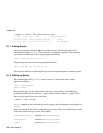Setting up RMS
Once RMS is running on all of the nodes, you set up a single partition as follows:
# rcontrol create partition=parallel configuration=day nodes=’atlas[0-63]’
# rcontrol start partition=parallel
You should now be able to run a parallel program across all 64 nodes, for example:
# prun -N64 hostname
...
# prun -N64 dping 0 32
...
9.3.3 Simple Day/Night Setup
In this example, the system is set up with two operating configurations: one called day
and the other called night. During the day, the resources are split into two partitions: a
login partition (called login) for program development and a parallel partition (called
parallel) for execution of short parallel programs. At night, all of the nodes are
assigned to a single partition (again called parallel) with a longer time limit for
running parallel jobs.
Use the following commands to create this pair of configurations:
# rcontrol create partition=login configuration=day type=login nodes=’atlas[0-7]’
# rcontrol create partition=parallel configuration=day type=parallel \
timelimit=600 nodes=’atlas[8-63]’
# rcontrol create partition=parallel configuration=night type=parallel \
timelimit=3600 nodes=’atlas[0-63]’
To start the day configuration, enter the following:
# rcontrol start configuration=day
...
To switch to the night configuration, use this command:
# rcontrol start configuration=night
...
Note that, after the switch, any jobs running on the parallel partition will continue to
run as the parallel partition in the configuration night has more nodes. However,
when changing back from night to day, you must decide what to do with any jobs that
are running on nodes ’atlas[0-7]’. The options are to wait for them to finish or to kill
them. To wait for them to finish, stop the partition with the wait option.
# rcontrol stop partition=parallel option=wait
# rcontrol start configuration=day
...
9-4 Setting up RMS


















